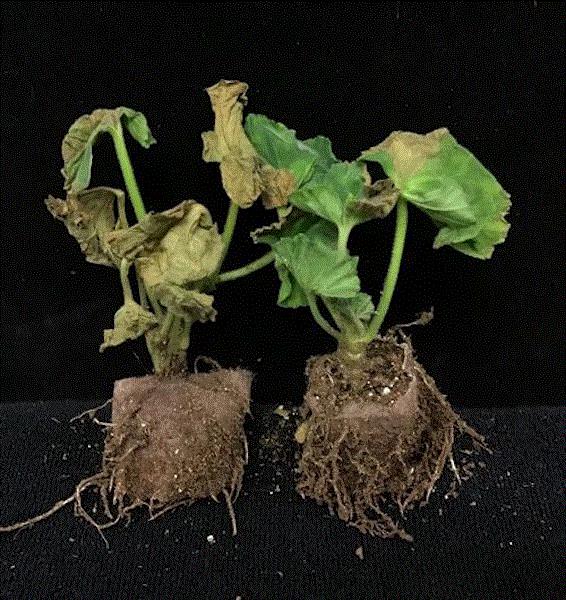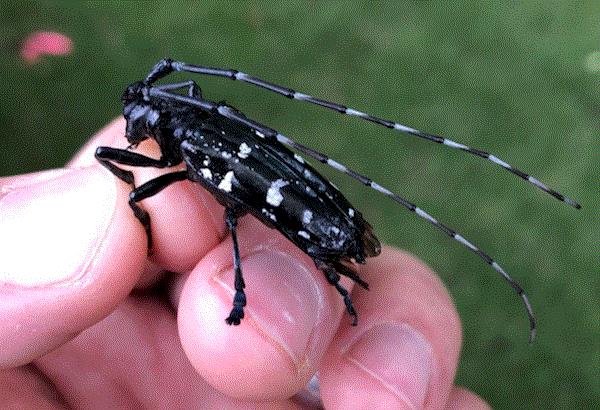Ralstonia wilt eradicated
Y’all probably remember that the USDA announced in April the detection of Ralstonia solanacearum race 3 biovar 2 (let’s be Star Wars-esque and call it R3B2) on geranium cultivar Fantasia Pink Flare in a Michigan greenhouse. If you don't remember, click here to read Chris Beytes’ piece on the detection. The geranium was imported from a Ball FloraPlant farm in Guatemala. Soon after the detection, the USDA traced the shipment and identified 288 growers in the United States and 55 greenhouses in Canada who had received portions of the 288,000 cuttings from the same facility.
Ralstonia solanacearum is not a new pathogen. Different races and biovars of the same bacterium have been causing bacterial wilts in tobacco, tomato and many plant species in the United States for many years. R3B2, on the other hand, is not a strain that exists in the United States and is a “cold tolerant” race that can be particularly devastating on tomatoes and potatoes in cooler climate.

Symptoms of Ralstonia solanacearum on young geraniums. (Photo credit: Michigan State University Plant and Pest Diagnostics)
This is not the first time R3B2 has been detected in the United States; the last detection was in 2004 and it was eradicated. Similar to this time, previous detection was also made on geranium cuttings from offshore facilities. If infected geraniums are purchased and planted in the landscape, R3B2 can spread to crop production fields. Because of the high impact of R3B2 on potato and tomato crops, USDA classifies it as a select agent pathogen and can impose quarantine on infected facilities.
If you want more technical details about R3B2, check out two documents from the University of Florida and USDA-ARS. They are good summaries of what’s known about R3B2 from previous research and recovery plans prepared by USDA-APHIS.
USDA-APHIS announced on June 11 that R3B2 has been successfully eradicated from the greenhouses that were identified. Although more than 650 greenhouses in 44 states were involved in this regulatory action, only a handful of them had actually received plants confirmed with R3B2.
Let’s chalk it down as another example of rapid response leading to rapid resolution of a potentially devastating disease problem.

Asian longhorned beetle found in South Carolina
While the eradication of R3B2 from greenhouses in the United States was celebrated, we also received news from my own backyard of invasion by another dangerous creature. USDA-APHIS and Clemson University’s Department of Plant Industry (DPI) announced on June 15 that an active infestation of Asian longhorned beetles (ALB) had been found in Hollywood, South Carolina. Hollywood, compared to the homonymous city in California, is but a tiny town of 5,000 residents about 30 minutes southeast of Charleston, South Carolina. I pass through the town at least once a month so I’m quite familiar with the neighborhood. A vigilant homeowner in the town reported the sighting, after urging by her son who is an extension professor in another state.
As a bug nerd, I think the ALB is beautiful—large (1-1.5 inches), and shiny black with white spots. But as an entomologist who worked with invasive species in southern Florida in a previous life and continues to battle some invasive insects in my current life, this detection concerns me greatly. Some have suggested that ALB is one of the most costly invasive insects, based on expenses incurred by the successful eradication programs in Illinois and New Jersey, and ongoing programs in Massachusetts, New York and Ohio. South Carolina represents the southern most state where ALB has been reported. It has a taste for maples, horsechestnuts, birches, willows, elms and other hardwoods. At the newly invaded site in Hollywood, red maples (common in the bottomland) are the major hosts.

An Asian longhorned beetle. (Photo credit: David Coyle, Clemson University)
USDA-APHIS and DPI are conducting a survey to delineate ALB’s distribution in and around Hollywood. Residents are encouraged to report findings of ALB, and to allow inspectors to access their properties.
There is no information on how ALB ended up in South Carolina. Perhaps the beetles were introduced through firewood brought to local campsites or homes by vacationing snowbirds. It was also likely that it may have been introduced through packing materials, and myriad other pathways of introduction. Hopefully the ongoing survey and investigation will give us an answer. This incidence points to the importance of not transporting firewood or other potential host materials of wood boring insects.
For more information about ALB, click here.
Do me a favor: Don't move firewood. If you need firewood, it's $3 a bundle that'll last you a night at my local state park. I'll even give it to you for free.

USDA-APHIS establishes offshore certification program
R3B2 and ALB are invasive organisms that can devastate agriculture in this country. It’s great that we can eradicate the populations or at the very least halt their spread, but it’s perhaps even better if we never have to worry about them invading at all. Ensuring that the plant materials we receive from offshore facilities and producers are relatively free of pests is a necessary step in reducing the risk of pest and disease introduction.
To that end, USDA-APHIS announced this week the establishment of a certification program for facilities that produce generally admissible unrooted cuttings. Offshore greenhouses participating in the Offshore Greenhouse Certification Program must meet the minimum standards for greenhouse construction, security, production, sanitation, pest management, training and recordkeeping, and agree to allow visits by USDA-APHIS officials. In return, cuttings produced under this certification program will receive less frequent inspections at the ports of entry.
The certification program is now accepting applications. For more information, click here.

Support consumer horticulture
I mainly work with clients in the realm of commercial horticulture in my day-to-day working life. Commercial horticulture involves folks who grow, install and maintain ornamental and other horticultural plants for a living. The other side of the same coin is consumer horticulture, broadly defined as indoor and outdoor growing of ornamental and edible plants that are not for monetary gain. I know I’m going to draw a lot of fire for these definitions, but these are based on my basic understanding of the concepts and are by no means definitive.
Commercial and consumer horticulture have a symbiotic relationship but commercial horticulture has traditionally received more support and funding from various state and federal funding agencies and trade associations. Some are attempting to change that equation.
The National Institute for Consumer Horticulture (NICH) is asking for submission of comments in support of increasing funding for consumer horticulture in the USDA National Institute of Food and Agriculture’s Urban, Indoor and Other Emerging Agriculture Production Research, Education, and Extension Initiative. You can click on this link to get more information about NICH, their mission, and the request for comments. You can also submit your comments by following the link on NICH website.
The American Society of Horticultural Science (ASHS) Consumer Horticulture/Master Gardener Professional Interest Group is also asking for folks to participate in a survey to identify research gaps in consumer horticulture and to learn about consumer horticulture perceptions. The results of this survey will be presented at the ASHS workshop in August. The long-term goal of the survey is to gather information to help NICH in its efforts to increase consumer horticulture research funding.
This anonymous survey takes about 10 minutes. Click here to participate.





That's all for this week. See y'all next time!

JC Chong
Professor of Entomology at Clemson University
This e-mail received by 23,162 subscribers like you!
If you're interested in advertising on PestTalks contact Kim Brown ASAP!